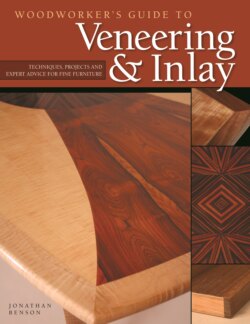Читать книгу Woodworker's Guide to Veneering & Inlay (SC) - Jonathan Benson - Страница 18
На сайте Литреса книга снята с продажи.
Buying veneers
ОглавлениеAfter cutting and processing, the veneer is sent to a distributor. Large distributors cater mainly to large customers, providing rotary-cut sheets of veneer to plywood manufacturers for use as face veneer or paper-backed sheets of uniform, not unusual, quality to furniture and cabinet factories. Distributors are able to provide full flitches, which can number in the thousands of square feet. The rotary-cut sheets and paper-backed veneers are by no means bad. Large manufacturers of furniture, cabinets, and wall paneling want to be able to sell a consistent product nearly identical to the pieces they advertise, so color and figure uniformity is required. That requirement usually eliminates unusual grain patterns and figures from the veneered plywood and paper-backed veneer markets.
Medium and small distributors cater to smaller manufacturers and workshops looking for limited quantity, high-quality flitch-cut raw veneers. Most can provide anything from one sheet to an entire flitch (Figure 2-16), and there are hundreds of species available. Distributors and dealers can be found on the Internet. Most of these companies post photos of the veneer from the actual flitch you will be buying. In addition, there is an increasing number of businesses that sell veneer in joined, matched, and backed sheets, made of more unusual types of wood and grain patterns, for the high-end furniture and construction markets. Many of the distributors also sell tape, glue, and other veneering supplies.
Most distributors will send a small free sample upon request. Many sell sample packs containing 4" by 6" samples of twenty or thirty diverse woods, which are great to have around the shop for inspiration. I make sample boards of the most popular species by gluing a small piece of veneer to a thin substrate and then sanding and finishing it. Displaying the samples allows me to show clients what the finished product might look like. I also keep a fair amount of veneer inventory in my shop, so when I bid on a job I can make a sample board from the flitch of veneer I plan to use. I cut the sample in half, send the client one half, put their name on the back of the other half, and keep it, eliminating confusion later.
Flitch-cut, un-backed raw veneer is most often sold in lengths of 8' to 12' and known as full-length veneer, unless specified otherwise. Veneer also can be ordered in shorter lengths, which are referred to as shorts. Ordering veneer in an even number of sheets produces most matching patterns. Also, including an extra 15 to 20 percent more than you think you’ll need is beneficial because ordering additional veneer a few weeks, or even a few days, later will probably mean the flitch originally ordered from is gone or the grain pattern has changed, and the veneer will not match.
Figure 2-14. A nick in the slicing knife will leave a raised track across the face of the veneer.
Figure 2-15. These leaves of cocobolo have not been clipped—they retain the sapwood and the spreading shape of the tree trunk.
Figure 2-16. A flitch of fiddleback makoré shows a very similar pattern from one leaf to the next.
Veneer Slicing and Figure
The way the veneer mill slices the log affects the appearance of the veneer. The effect can be controlled by the orientation of the knife and log during the cutting process. There are two broad categories of veneer slicing: rotary and flat.
